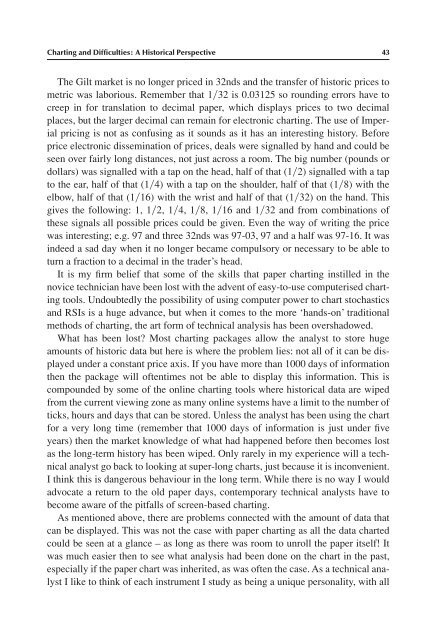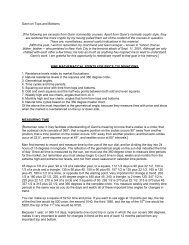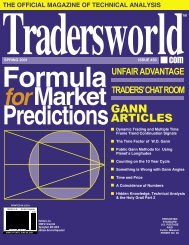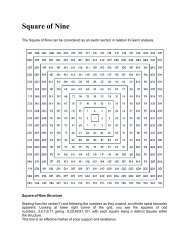Fibonacci and Gann Applications in Financial Markets
Fibonacci and Gann Applications in Financial Markets
Fibonacci and Gann Applications in Financial Markets
You also want an ePaper? Increase the reach of your titles
YUMPU automatically turns print PDFs into web optimized ePapers that Google loves.
Chart<strong>in</strong>g <strong>and</strong> Difficulties: A Historical Perspective 43<br />
The Gilt market is no longer priced <strong>in</strong> 32nds <strong>and</strong> the transfer of historic prices to<br />
metric was laborious. Remember that 1�32 is 0.03125 so round<strong>in</strong>g errors have to<br />
creep <strong>in</strong> for translation to decimal paper, which displays prices to two decimal<br />
places, but the larger decimal can rema<strong>in</strong> for electronic chart<strong>in</strong>g. The use of Imperial<br />
pric<strong>in</strong>g is not as confus<strong>in</strong>g as it sounds as it has an <strong>in</strong>terest<strong>in</strong>g history. Before<br />
price electronic dissem<strong>in</strong>ation of prices, deals were signalled by h<strong>and</strong> <strong>and</strong> could be<br />
seen over fairly long distances, not just across a room. The big number (pounds or<br />
dollars) was signalled with a tap on the head, half of that (1�2) signalled with a tap<br />
to the ear, half of that (1�4) with a tap on the shoulder, half of that (1�8) with the<br />
elbow, half of that (1�16) with the wrist <strong>and</strong> half of that (1�32) on the h<strong>and</strong>. This<br />
gives the follow<strong>in</strong>g: 1, 1�2, 1�4, 1�8, 1�16 <strong>and</strong> 1�32 <strong>and</strong> from comb<strong>in</strong>ations of<br />
these signals all possible prices could be given. Even the way of writ<strong>in</strong>g the price<br />
was <strong>in</strong>terest<strong>in</strong>g; e.g. 97 <strong>and</strong> three 32nds was 97-03, 97 <strong>and</strong> a half was 97-16. It was<br />
<strong>in</strong>deed a sad day when it no longer became compulsory or necessary to be able to<br />
turn a fraction to a decimal <strong>in</strong> the trader’s head.<br />
It is my firm belief that some of the skills that paper chart<strong>in</strong>g <strong>in</strong>stilled <strong>in</strong> the<br />
novice technician have been lost with the advent of easy-to-use computerised chart<strong>in</strong>g<br />
tools. Undoubtedly the possibility of us<strong>in</strong>g computer power to chart stochastics<br />
<strong>and</strong> RSIs is a huge advance, but when it comes to the more ‘h<strong>and</strong>s-on’ traditional<br />
methods of chart<strong>in</strong>g, the art form of technical analysis has been overshadowed.<br />
What has been lost? Most chart<strong>in</strong>g packages allow the analyst to store huge<br />
amounts of historic data but here is where the problem lies: not all of it can be displayed<br />
under a constant price axis. If you have more than 1000 days of <strong>in</strong>formation<br />
then the package will oftentimes not be able to display this <strong>in</strong>formation. This is<br />
compounded by some of the onl<strong>in</strong>e chart<strong>in</strong>g tools where historical data are wiped<br />
from the current view<strong>in</strong>g zone as many onl<strong>in</strong>e systems have a limit to the number of<br />
ticks, hours <strong>and</strong> days that can be stored. Unless the analyst has been us<strong>in</strong>g the chart<br />
for a very long time (remember that 1000 days of <strong>in</strong>formation is just under five<br />
years) then the market knowledge of what had happened before then becomes lost<br />
as the long-term history has been wiped. Only rarely <strong>in</strong> my experience will a technical<br />
analyst go back to look<strong>in</strong>g at super-long charts, just because it is <strong>in</strong>convenient.<br />
I th<strong>in</strong>k this is dangerous behaviour <strong>in</strong> the long term. While there is no way I would<br />
advocate a return to the old paper days, contemporary technical analysts have to<br />
become aware of the pitfalls of screen-based chart<strong>in</strong>g.<br />
As mentioned above, there are problems connected with the amount of data that<br />
can be displayed. This was not the case with paper chart<strong>in</strong>g as all the data charted<br />
could be seen at a glance – as long as there was room to unroll the paper itself! It<br />
was much easier then to see what analysis had been done on the chart <strong>in</strong> the past,<br />
especially if the paper chart was <strong>in</strong>herited, as was often the case. As a technical analyst<br />
I like to th<strong>in</strong>k of each <strong>in</strong>strument I study as be<strong>in</strong>g a unique personality, with all






